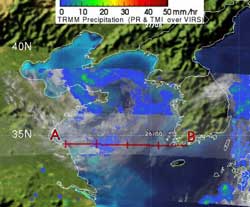NASA sees Tropical Depression Meari about to cross North Vietnam

TRMM saw Tropical Depression Meari on June 26 at 1210 UTC (8:10 a.m. EDT) as it neared landfall in North Korea. The yellow and green areas indicate moderate rainfall between .78 to 1.57 inches per hour. There were no red areas seen from TRMM, which usually indicate heavy rainfall. Credit: NASA/SSAI, Hal Pierce<br>
TRMM captured an image of the rainfall in Tropical Depression Meari on June 26 at 1210 UTC (8:10 a.m. EDT). Most of the rainfall was light to moderate in the system, with the heaviest rain near the center of circulation falling at a rate between .78 to 1.57 inches (20 and 40 mm) per hour.
Satellite imagery showed that Meari had become more elongated (because of wind shear) which indicates that the storm is weakening. Between the elongation of the system and the weak convection (lighter rainfall), Meari has lost much of its energy.
On June 27 at 0000 UTC (June 26 at 8 p.m. EDT), the Joint Typhoon Warning Center issued their last advisory on the system. At that time it was about 115 nautical miles west- Northwest of Seoul, South Korea, near 38.3 North latitude and 124.7 East longitude. It was moving to the northeast at 11 knots (13 mph/20 kmh).
The increased wind shear and cooler sea surface temperatures where Meari is now located have taken the steam out of the system. It is expected to fall apart as it crosses over the rough landscape of the Hamgyeong Mountain Range. The remnants of this system may track through North Korea and enter the Sea of Japan. It will be watched for possible regeneration at that time.
Media Contact
More Information:
http://www.nasa.govAll latest news from the category: Earth Sciences
Earth Sciences (also referred to as Geosciences), which deals with basic issues surrounding our planet, plays a vital role in the area of energy and raw materials supply.
Earth Sciences comprises subjects such as geology, geography, geological informatics, paleontology, mineralogy, petrography, crystallography, geophysics, geodesy, glaciology, cartography, photogrammetry, meteorology and seismology, early-warning systems, earthquake research and polar research.
Newest articles

Making diamonds at ambient pressure
Scientists develop novel liquid metal alloy system to synthesize diamond under moderate conditions. Did you know that 99% of synthetic diamonds are currently produced using high-pressure and high-temperature (HPHT) methods?[2]…

Eruption of mega-magnetic star lights up nearby galaxy
Thanks to ESA satellites, an international team including UNIGE researchers has detected a giant eruption coming from a magnetar, an extremely magnetic neutron star. While ESA’s satellite INTEGRAL was observing…

Solving the riddle of the sphingolipids in coronary artery disease
Weill Cornell Medicine investigators have uncovered a way to unleash in blood vessels the protective effects of a type of fat-related molecule known as a sphingolipid, suggesting a promising new…





















